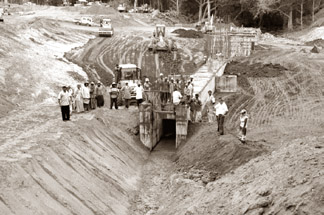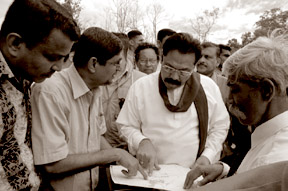|
observer |
|
|
|
|
|
OTHER LINKS |

|

|

|
Weheragala comes alive...
|
|
|
Being blessed by great rivers such as the sacred and magical Menik Ganga, and a host of 'wewas' and 'oyas', at a glance it seems as though there is water everywhere in the region. Nevertheless, there is no water even to quench the thirst of human and wild life.
Ironically, the sanga, veda, guru, govi, kamkaru idealogies of the Bandaranaikes, the 'Gam Udawa' concept of Ranasinghe Premadasa, among others have miserably failed to diagnose and arrest the situation in the past, in order to uplift the living standards and livelihoods of the regional inhabitants depending solely on agro-based industries for a living.
However, a true son of Mother Lanka, President Mahinda Rajapaksa, from Ruhuna Giruwa Pathuwa, has committed himself to address the crisis by taking measures as envisioned in his Mahinda Chintanaya'. History will be re-written and a long-felt need will soon become a reality.
The semi-dessert areas of the Moneragala and Hambantota districts, inclusive of Kataragama, Hambantota, Weerawilla, Thanamalvilla and Tissamaharama among others, will be immensely benefitted by the proposed accelerated Weheragala Reservoir project now already underway, and nearing completion in December this year, under the auspices of President Mahinda Rajapaksa.
The great King Parakramabahu was of the view that not a single drop of water should flow to the sea sans utilisation. The Weheragala Reservoir project, per se, a brainchild of President Rajapaksa, is based on this premise.
A surplus of water from the Menik Ganga, uncontrollably flows into the sea annually, inundating and causing much havoc and devastation to life and property in transit. This vast, unutilized water resource is to be trapped and collected by the proposed 2030 metre long, 75 million cubic metre capacity Weheragala Reservoir.
Weheragala
|
|
The Weheragala reservoir will provide water to Galamuna, Gettupana, Hangunaara and the southern and left banks of Kirindioya project. A 23 km long 'Feeder Canal' would carry a capacity of 65 million cubic metres of water annually, to the Lunugamwehera from the Weheragala reservoir.
The proposed scheme, to be completed at an estimated amount of around Rs.1800 million, will develop an area of 5700 Hectares, and uplift the livelihoods of 5600 farming families engaged in paddy and minor crop cultivation. The farming community will have the ability of cultivating both the Yala and Maha kanna.
Albeit annually, the Menik Ganga runs dry in the months of August and September, on completion of the project, the maintenance of the water levels at 15 to 20 cubic metres per second, is ensured throughout the year.
This will bring a sustainable solution to the potable water crisis in Kataragama, a long-felt need in the area for decades.
The utilisation of solely indigenous know-how, expertise and resources in the said project, is another unique and salient feature to be noted and emulated. Similar projects have been undertaken by foreign contractors at comparatively high costs, resulting in the loss of valuable foreign exchange to the country.
Project
The project has generated around 700 job opportunities already, with the prospect of increasing the same by another 300, for locals in the neighbouring areas of Kataragama, Hambantota, Weerawilla, Thanamalwilla and Tissamaharama, at an average daily wage of around Rs.456. An allocation of Rs.150 million has been set aside as wages for the whole project.
The Irrigation Ministry Secretary A.D.S.Gunawardena who is directly in charge of the project, told the Sunday Observer that minor environmental hazards, such as the clearing of the forest is insignificant when compared with the benefits acquired therein. However, he said that in coordination with the Forest department, they have planned a massive re-plantation scheme to minimise the loss.
He further said that the project had also helped to solve the 'squatter' problem which had a detrimental impact on the forest, as they were illegally clearing the jungle and also destroying wild life in the area. The project thus helped them to re-settle these 'squatters' in a more organised manner at alternative sites. Gunawardena noted that once the water problem is solved, the Wild Life department has plans of introducing new species of birds in and re-settling wild elephants into the forest areas around Weheragala, to attract tourists in the future. "The quality of the flora and fauna of the region will be enhanced after the project is completed", he added.









